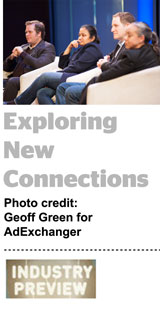 The ability to connect consumers across devices represents a small but increasingly viable portion of marketers’ campaign strategies.
The ability to connect consumers across devices represents a small but increasingly viable portion of marketers’ campaign strategies.
During day one of AdExchanger’s Industry Preview 2014, several CEOs and marketing execs commented on the growing use of cross-device recognition technology as a marketing tool.
According to AOL CEO Bob Lord, 45% of his clients’ display spend is being directed toward cross-device linkage campaigns and its linkage capabilities are powered mainly by AOL’s log-in, which connects users across its properties.
Panelists Kamakshi Sivaramakrishnan, CEO of Drawbridge; Nadya Kohl, VP of global strategy and business development at Experian Marketing Services; and DataXu CTO Bill Simmons also weighed in on cross-device targeting trends.
One of the challenges in cross-device recognition campaigns is measuring the accuracy of the results. When asked by moderator Ari Paparo (EVP of product management at Bazaarvoice) the percentage of consumers that can be accurately identified through cross-device recognition technologies, the panelists gave a range from 50% to 80%.
But whether achieving that high end is necessary, Sivaramakrishnan said, depends on a number of factors.
“The accuracy rate is not a standalone question,” she explained. “It’s about how accurate do you need to be, depending on the campaign strategy that you’re employing. If your advertising strategy is focused on … being able to leverage intent to bring a specific product to top of mind through retargeting, then yes, you need a very high accuracy rate, but you might have broader goals.”
Simmons and Kohl both noted that because cross-device recognition methods were still emerging, it was difficult to pinpoint the accuracy rate and suggested that it could be at 50% or 75%, respectively.
In regards to other challenges, privacy complications could act as a deterrent, Kohl noted.
“Marketers believe that harmonizing messages and offers across devices has an impact in terms of customer experience, but you have to do this in a way that’s privacy-sensitive,” she said. “There are also explicit risks in getting it wrong. … Nobody wants to touch privacy because it’s super scary.”
And while data behemoths like Google might seem on the surface to be best positioned to leverage cross-device technologies due to a wealth of consumer data, marketers, according to Simmons and Kohl, are increasingly reluctant to give their best assets to the company. Kohl added that marketers increasingly perceive themselves as ”data owners instead of publishers” and think more strategically about how to “build high-value audiences from their data.”
Sivaramakrishnan, who was a senior research scientist at AdMob and worked for Google post-acquisition, pointed out that Google may focus on other areas besides expanding its cross-device recognition capabilities. “Just because Google can do something does not mean it will,” she said.
Looking ahead, all three panelists agreed that marketers are becoming more aware of cross-device recognition technology, even though, as Kohl observed, “there are a lot of barriers to taking on great cross-device marketing and … the CMO should be thinking about how that linkage strategy looks.”












